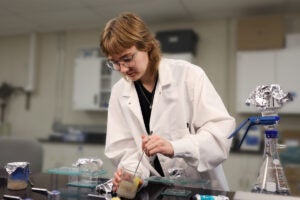AUSTIN, Texas —The U.S. Department of Energy is providing approximately $3.5 million for a three-year period to researchers at The University of Texas at Austin as part of a program that seeks to slow or halt the decline in U.S. oil production.
While petroleum products comprise about 40 percent of all energy consumed in the United States each year, domestic oil production continues to shrink. The DOE has developed a program to encourage research into new technologies and other methods that would make petroleum production more efficient.
UT Austin has received funding for four of 23 projects chosen in the DOE’s first round of new oil technology funding — more grant money than any other institution.
Dr. Carlos Torres-Verdin, assistant professor in the UT Austin department of petroleum and geosystems engineering, and Dr. Mrinal K. Sen, senior research scientist at the Institute for Geophysics, received $1,083,205 in DOE funding to design and test a more accurate computer model of oil and gas flow based on oil production, seismic and geologic data.
“This description will provide reservoir engineers with much-needed accurate information about hydrocarbon existence and will allow them to predict fluid movements as a result of production,” said Torres-Verdin. He said the program would allow reservoir engineers to better plan the extraction of oil, increasing production and lowering operating costs.
Sen said: “The goal of the project is to generate a very high-resolution picture of an oil reservoir using statistical theory to integrate three-dimensional seismic data with well-log data. Currently, there is no such computer program available to do this.
“Since the research results will help in the production planning for oil reservoirs, the study is of tremendous interest to the oil industry,” Sen added.
Several oil companies will provide data and technical expertise for the project, and the University will contribute $286,000.
Other University researchers plan to use DOE funds to examine the size, clustering and connectivity of rock fractures in fractured reservoirs, where the rock is systematically cracked and provides pathways for fluids such as oil. Understanding the formation of fractures, and the effects on the movement of oil or injected fluids, will improve production processes and allow the consumption of oil in unconventional petroleum reserves, researchers said.
“Naturally fractured reservoirs are an increasingly important resource in the United States because of the need to drill into more geologically complex areas to find new sources of petroleum,” said Dr. Jon E. Olson, an assistant professor and research scientist at the Center for Petroleum and Geosystems Engineering.
“The ultimate application of our work would be to say that, for a given fractured reservoir, to economically extract the oil from the ground, a petroleum company will need this many wells. They will have to be horizontally drilled. And the wells will have to be oriented in this direction to maximize intersections with the fractures that bring fluids to the well,” Olsen said.
Olson works with Dr. Larry W. Lake, a professor of petroleum and geosystems engineering who holds the W.A. “Monty” Moncrief Centennial Chair in Petroleum Engineering, and Dr. Stephen E. Laubach, a senior research scientist at the Bureau of Economic Geology. They will receive $836,716 in DOE funding and $316,000 from UT Austin.
University researchers also are using a new chemical flooding simulator to better model oil reservoirs and production.
Dr. Gary A. Pope, director of the Center for Petroleum and Geosystems Engineering, said he and his colleagues have developed a computer model called UTCHEM, which simulates a variety of underground chemical, biological and physical phenomena that can occur in deep oil-bearing formations. Pope is a professor of petroleum and geosystems engineering and holds the Texaco Centennial Chair in Petroleum Engineering.
“DOE will fund the continuation of this long-term model development so that these important and widely used features can be incorporated into a much faster computer program that runs in parallel on many computers simultaneously — and thus will enable modelers to simulate problems 100 times larger than currently feasible,” explained Pope. “Such research combining petroleum engineering and applied and computational mathematics expertise has great benefits in a number of academic and industrial applications.”
The computer modeling will minimize the risk involved in oil development decisions and make oil production more efficient and cost-effective.
Pope’s colleagues are: Dr. Kamy Sepehrnoori, a professor of petroleum and geosystems engineering, also the Nationsbank of Texas, N.A., Centennial Professor in Petroleum engineering; Dr. Mojdeh Delshad, a research engineer at the Center for Petroleum and Geosystems Engineering; and Dr. Peng Wang, a research associate at the Center for Petroleum and Geosystems Engineering. The project will receive over $930,801 from the DOE and $233,000 from the University.
Dr. William R. Rossen, an associate professor of petroleum and geosystems engineering, intends to improve oil production by studying the foams created by injecting water, reactive substances and gases into oil reservoirs, which may increase the production potential of gas injection processes.
About 12 percent of oil production involves the injection of gases, including steam and carbon dioxide, to make oil flow more easily during extraction.
“The largest group of ïimproved oil recoveryÌ processes involves injecting gases into petroleum reservoirs to help drive more oil out,” said Rossen. “The major problem with these processes is that the gas — much less viscous and less dense than the oil it’s supposed to displace — tends to go over and around the oil rather than driving it efficiently to the production well. Injecting some detergent and water with the gases turns them into foams, which are much more viscous. It helps divert the gases back into the oil-rich regions of the reservoir.”
Rossen said that foam also can be used to direct the acids that clear debris from freshly drilled holes, and to direct gases or liquids intended to clean up underground spills of toxic liquids.
“One of the strengths of my research program is that we are conducting research on all three of these areas of application,” he said. “The insights from one of these areas have often led to advances in the other areas.”
The project will be supported by $639,522 from the DOE and $198,000 from UT Austin.
For more information, contact Becky Rische at the UT Austin College of Engineering at (512) 471-7272 or Dr. Katherine K. Ellins at the UT Austin Institute for Geophysics (512) 232-3251.



